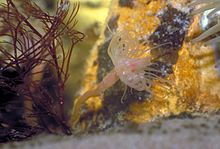
Hydrozoa is a taxonomic class of individually very small, predatory animals, some solitary and some colonial, most of which inhabit saline water. The colonies of the colonial species can be large, and in some cases the specialized individual animals cannot survive outside the colony. A few genera within this class live in freshwater habitats. Hydrozoans are related to jellyfish and corals and belong to the phylum Cnidaria.

Tubularia is a genus of hydroids resembling furry pink tufts or balls at the end of long strings, owing to the common names "pink-mouthed" or "pink-hearted" hydroids.

The beadlet anemone is a common sea anemone found on rocky shores around all coasts of the British Isles. Its range extends to the rest of Western Europe and the Mediterranean Sea, and along the Atlantic coast of Africa as far south as South Africa and Australia.

Protanthea simplex is a species of sea anemone found in deep water off the coasts of north west Europe. It is the only species in the monotypic genus Protanthea.

Tubularia indivisa is a species of large hydroid discovered in 1758. T. Indivisa is observed to have around 40 oral tentacles surrounded by 20-30 larger tentacles. This outer ring of larger tentacles are paler and longer than the inner ring of oral tentacles. The tough and yellow unbranched stems are clustered together and fuse at the base of the colony. The color of the single polyp itself can range from a pale pink to a red and in spring (mainly), red or pink gonotheca grow between the inner set of oral tentacles. The gonotheca can be described as "part of hydroid producing gametes where eggs are often incubated until the larva is released". The polyps are observed with a conical or flask shape and present only in spring, with the diameter of the polyp and tentacles being around 15mm in length and the overall height observed of the entire organism ranging from 100-150mm.
Cerianthus lloydii is a species of tube-dwelling sea anemone in the family Cerianthidae. It is sometimes called the lesser cylinder anemone and is found in shallow seas around the coasts of north west Europe.
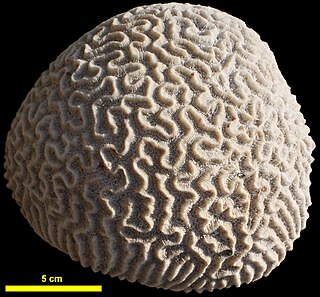
Pseudodiploria clivosa, the knobby brain coral, is a colonial species of stony coral in the family Mussidae. It occurs in shallow water in the West Atlantic Ocean and Caribbean Sea.

Ectopleura is a genus of hydrozoans in the family Tubulariidae.

The tubular hydroid is a species of hydroid cnidarian, and is found in temperate coastal waters. It is a member of the family Tubulariidae.

Thuiaria articulata, the jointed hydroid or sea spleenwort, is a branching colonial hydroid in the family Sertulariidae.
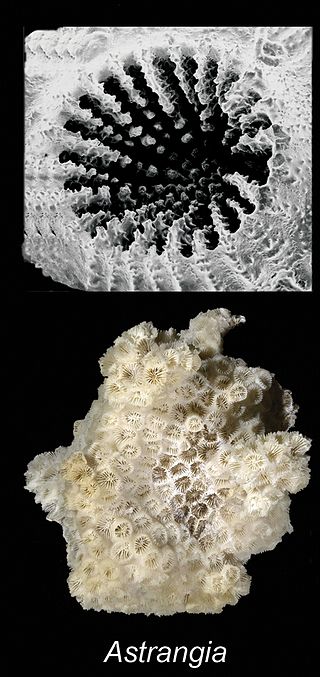
Astrangia poculata, the northern star coral or northern cup coral, is a species of non-reefbuilding stony coral in the family Rhizangiidae. It is native to shallow water in the western Atlantic Ocean and the Caribbean Sea. It is also found on the western coast of Africa. The International Union for Conservation of Nature lists this coral as being of "least concern". Astrangia poculata is an emerging model organism for corals because it harbors a facultative photosymbiosis, is a calcifying coral, and has a large geographic range. Research on this emerging model system is showcased annually by the Astrangia Research Working Group, collaboratively hosted by Roger Williams University, Boston University, and Southern Connecticut State University

Catriona aurantia is a species of sea slug, an aeolid nudibranch, a marine gastropod mollusk in the family Trinchesiidae. It was incorrectly synonymised with Catriona gymnota from the Western Atlantic but shown to be a distinct species by DNA analysis.

Favites is a genus of stony corals in the family Merulinidae. Members of this genus are native to the Indo-Pacific region and their ranges extend from the Red Sea through the Indian Ocean and Western Pacific Ocean as far as Japan, the Line Islands and the Tuamotu Islands.

Platygyra daedalea, sometimes known as the lesser valley coral, is a colonial species of stony coral in the family Merulinidae. It occurs on reefs in shallow water in the Indo-Pacific region. It is a common species and the International Union for Conservation of Nature has assessed its conservation status as being of "least concern".

Orbicella is a genus of stony corals in the Merulinidae family. The Orbicella species complex comprises three sister species, namely Orbicella faveolata, Orbicella annularis and Orbicella franksi, all of which are shallow-water, zooxanthellate species and are native to the tropical western Atlantic Ocean, the Caribbean Sea and the Gulf of Mexico.
Synoicum pulmonaria, the tennis ball ascidian or sea-fig, is a species of colonial sea squirt, a tunicate in the family Polyclinidae. It occurs in shallow water in the northeastern Atlantic Ocean, the North Sea and the English Channel, and also, to a lesser extent, in the northwestern Atlantic Ocean.

Actinothoe sphyrodeta, the sandalled anemone, is a small sea anemone in the family Sagartiidae. It is native to the northeastern Atlantic Ocean and is common on the north, west and south coasts of Britain. It is usually grey or whitish but may have an orange oral disc. The translucent white tentacles that grow around the edge of the oral disc can number up to 120.
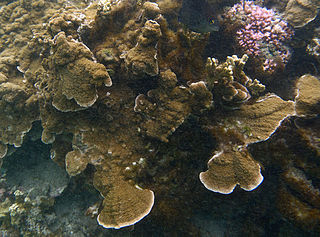
Echinophyllia aspera, commonly known as the chalice coral, is a species of large polyp stony corals in the family Lobophylliidae. It is a colonial coral which is partly encrusting and partly forms laminate plates or tiers. It is native to the western and central Indo-Pacific.

Halecium muricatum, commonly known as the sea hedgehog hydroid, is a species of hydrozoan in the family Haleciidae. It occurs mainly in arctic and northern temperate waters, in both the Atlantic and Pacific Oceans.
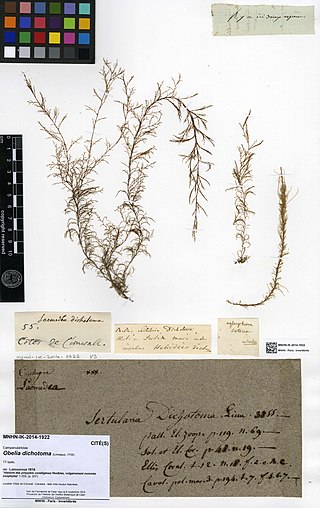
Obelia dichotoma is a broadly distributed, mainly marine but sometimes freshwater, colonial hydrozoan in the order Leptothecata that forms regular branching stems and a distinctive hydrotheca. O. dichotoma can be found in climates from the arctic to the tropics in protected waters such as marches and creeks but not near open coasts like beaches in depths up to 250m. O. dichotoma uses asexual and sexual reproduction and feeds on mainly zooplankton and fecal pellets. Obelia dichotoma has a complex relationship with the ecosystem and many economic systems.
